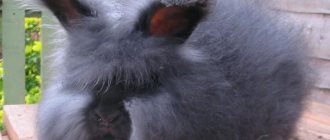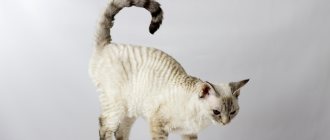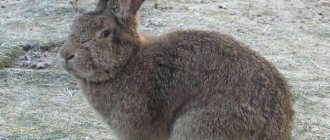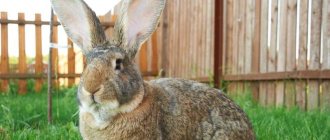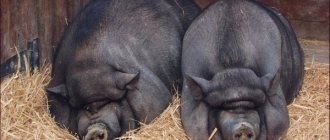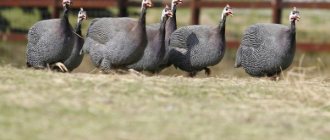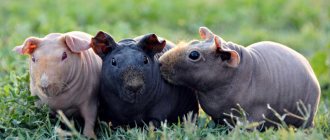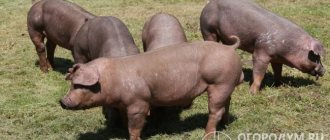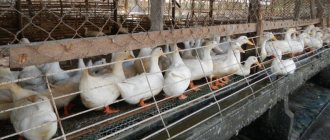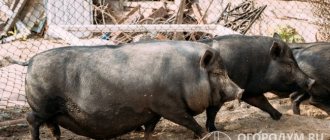The breed group of rabbits “Rex” includes animals that have high-quality, beautiful fur of a very original structure. Most of these animals belong to the category of productive ones, but there are also decorative (dwarf) varieties.
The popularity of Rex rabbits (pictured) in commercial farming is due to the high quality of their skin and fur.
Let's get to know the Rex more closely and start with a brief description in the table of the characteristics of productive representatives of the breed:
| Parameter | Characteristic |
| Animal | Rabbit (Oryctolagus cuniculus L) |
| Breed group | Rex |
| Productive type | Meat skin |
| Live weight of an adult | 4-5 kg |
| Body length | 54 cm |
| Ear length | 11-12 cm |
| Fur color | White, black, bluish, different shades of gray, brown, red, yellow; There are bicolor (spotted) varieties |
| Age of sexual maturity of a female | About 5 months |
| Multiple pregnancy | 4-5 cubs per litter (sometimes up to 7) |
| Deadline for gaining slaughter weight | More than 8 months |
| Killer exit | Up to 60% |
| Quality of skin and fur | Very high |
| Sustainability | For infectious diseases – average; to temperature changes – low (animals suffer greatly from overheating); to humidity – low |
| Registration in the State Register of the Russian Federation | Turned off |
Description of the breed
Photo:
Rex rabbits are a typical representative of the meat and skin direction in rabbit breeding. They are valued for their high-quality fur, as well as dietary meat with a pleasant taste.
External features and breed standard:
- rabbits grow up to 40-55 cm in length, have an elongated body and thin bones. The average weight of males is 4.5 kg, females are slightly less - 3 kg;
- at the age of 30 days, rabbits weigh up to 650 g. They slowly gain weight, by 130 days the body weight reaches only 2.4 kg;
- The muzzle of males is more powerful and wider than that of female rabbits. The head has a slightly rounded shape;
- in a healthy individual, the ears should stand strictly vertical, the average length is 11 cm;
- the tail is weakly expressed and lies close to the back;
- limbs of medium length;
- the eyes are brown, the claws should be the same shade or slightly darker;
- The fur is short-haired, up to 2 cm in length. Pleasant to the touch, the texture resembles high-quality velvet. After stroking in the opposite direction, the fur quickly falls into place;
- The mustache is a distinctive feature of the breed. They are very small in size and highly curved. Curvature appears even in newborn rabbits.
Rexes have a peaceful and calm character. They quickly get used to their owner, love to play and communicate. Adult healthy individuals should not demonstrate aggressiveness towards humans and other individuals.
Rabbits of this breed are very clean animals, they quickly get used to the tray and eat carefully. They do not tolerate rude treatment or loud noises. When frightened, they may experience aggression and bite. They note that rexes are sensitive to unpleasant odors; you should wash your hands before contacting the animal.
Performance
Despite high demand, rabbits grow very slowly. By the age of eight months, individuals weigh approximately 3−3.5 kg, monthly weight gain is 200−300 grams.
Plush rodents are raised to produce tender dietary meat that does not have a specific smell and taste, unlike lamb or beef. The skin is highly valued; the fur is used in the production of fur products. Rex fur coats last a long time and do not deform, especially dark colors.
Due to the low number of cubs in the litter and the slow growth of representatives, the cost of the products is high, and the quality is difficult to distinguish from rare and valuable furs.
Origin story
Rexes are a young breed of rabbits. The appearance of characteristic species characteristics was the result of a random gene mutation. In 1919, a French farmer discovered his Belgian giant's litter with modified fur.
It was softer and shorter than that of the parent specimens. It was this trait that was subsequently fixed as a result of further selection, the breed was named after the Latin word meaning “king, king.”
In 1924, Rex rabbits were first exhibited at an exhibition in Paris, where they received rave reviews. After this, animals began to be exported to other countries, and the breed became in demand in the meat and skin industry.
In 1988, by crossing Dutch rabbits and rex rabbits, a dwarf variety called the Mini Rex rabbit was bred. They have a compact size and shorter hair length, making them suitable for keeping as a pet.
Nutrition
The diet of Rex rabbits must include hay. Since the stomach of these rodents does not actually have muscles, they need to constantly eat to push food into the intestines. In the warm season, they need to be given grass regularly, but not freshly cut, but slightly dried in the shade.
It’s definitely not worth experimenting with unfamiliar herbs, since to plants like datura, henbane, hemlock, buttercup, nightshade, geranium, cornflower, horsetail and many others, a rabbit can have the most unpredictable reaction, even death.
Throughout the year, ornamental rodents can be fed carrots, beets, spinach, cauliflower leaves and stems, tomatoes, pumpkin and turnips. Like chinchillas, Rex rabbits are happy to eat combined food; in winter, it is recommended for rodents to sprout oats. You can also give them twigs of spruce, alder, birch and apple trees, which they eat with great appetite.
Varieties, color
The breed standard includes 20 colors, which is valuable for making clothing because the fur does not need to be dyed. The most common types of Rex are white, blue, black and chocolate fur.
The most famous varieties of the breed:
- Marder . The color of the fur imitates the color of a marten. Rabbits of traditional size, as well as dwarf representatives, were bred in this direction. They are considered the most decorative and expensive variety of the breed;
- Castor . The skin resembles natural beaver fur. Dwarf rexes of this species are especially popular;
- Chinchilla . The fur is as close as possible to the color of a chinchilla. When properly processed, it is practically indistinguishable from the skin of this animal; it is often used to create clothing;
- Mini . Grown only as an ornamental animal. The weight of an adult does not exceed 2 kg, and there is a wide variety of fur colors.
Since 2002, long-eared rexes, bred for home keeping, have become very popular. They are distinguished by very beautiful hair, small size and large hanging ears. This variety is not yet included in the breed standard.
Reviews from owners
Rex rabbit fur coats of chinchilla color receive most of the flattering reviews. In terms of protection from the cold, they are not inferior to their chinchilla counterparts, they look no worse, and are much cheaper.
To take full advantage of the latter advantage, buyers prefer domestically produced fur coats sold directly from clothing factories. The only thing that many do not take into account is the lack of resistance of this material to moisture.
No less popular than chinchilla options are custom-cut Rex rabbit fur coats. The lightness of the material allows owners of maxi-length products not to feel the weight of the clothing.
Often the choice is made between the Rex rabbit option and the mink one, taking into account the price and practicality of the purchase.
As for the durability of the product, many buyers claim that with proper care, a fur coat can withstand at least 10 seasons. [Total: 7 Average: 3.9/5]
Breeding
One of the main disadvantages of the Rex breed is low fertility. In one litter, the female brings up to 5 rabbits. They have a good maternal instinct, but with illiterate care there is a high risk of death of the offspring. To preserve the babies, it is recommended to place the baby rabbits with other breeds.
Puberty occurs at 3-4 months. Only young and healthy males should be selected for mating. It is recommended that mating be carried out in the male's cage to avoid aggression from the female rabbit.
The process is carried out exclusively during the period of sexual heat of females, which in the summer is repeated cyclically every other week and lasts up to 8 days. Usually a specific pair is selected for mating to preserve species characteristics; on large farms the coverage rate is 1 male for 6-8 females.
The mating process takes up to 30 seconds to achieve 100% fertilization; it is advisable to carry out coating twice with an interval of 5 minutes. Some rabbit breeders practice control mating after 5-6 days.
The duration of pregnancy is 28-31 days, giving birth usually occurs in the autumn. Animals have a bicornuate uterus, which complicates the birth process.
The presence of a person is mandatory to reduce the risk of death of the female. Average duration is 60 minutes. With high-quality feeding, the milk production of females is high; they can easily feed up to 6 babies.
Long-lived rabbits
In terms of average life expectancy, dwarf rabbits are not long-livers. Today, for pets to live 8 years is already a record. Most often, if all the rules for caring and feeding animals are followed, the animal lives no more than 6-7 years. But there are also exceptions. Several record holders even made it into the Guinness Book of Records. However, the oldest furry was not given the honor of getting there. In Scotland, according to some information, an eared dog lived in ordinary apartment conditions and died of old age only at the age of 24, but nothing is known about its breed.
Among the celebrities of the animal world recorded by representatives of the Book of Records, the most famous are the dwarf rabbits Do from the USA (died by the age of 17) and Floppy from England (died at the age of 19). It is very difficult to reach this age without certain genetic characteristics of individual breeds.
Feeding
Rexes are unpretentious when it comes to feeding, but proper diet planning directly affects the health of the rabbits and the condition of their fur.
The following ingredients are used to compose your daily diet:
- in winter - grain, hay, compound feed, root vegetables and vegetables, twigs;
- in summer - grains and cereals, grass, tree branches, fresh vegetables.
Regardless of the season, it is recommended to add vitamin supplements for rabbits. Feeding rates are calculated taking into account age, gender and the presence of lactation.
Approximate volume:
- female and male during the resting period - 160 g;
- during the period of preparation for mating - 220 g;
- female during lactation - 300-550 g;
- young animals from 40 to 60 days – 125 g;
- young animals from 61 to 90 days – 175 g.
It is advisable to feed three times a day - at 8, 14 and 19 hours. There should always be access to fresh and clean water in the cage; the number of feeders and drinkers depends on the size of the herd.
It is not recommended to feed rabbits red beets, cauliflower, tomatoes and beans. The consumption of pine twigs and potato tops should be limited. It is strictly forbidden to give herbs growing in swampy areas, as well as ornamental plants.
Conditions for longevity
The decorative rabbit is a creature with a delicate immune system, and few breeders can keep it in good condition. It is the state of health of animals that most often influences the fact that furry creatures leave this world just a few years after birth. To maximize the life of your pets, you should:
- undergo regular veterinary examinations and vaccinations;
- monitor the quality of the animal’s diet;
- take good care of it;
- castrate males;
- Organize daily walks for the animal.
Also, the life expectancy of domestic animals depends on:
- breeds;
- the health of the rabbit's parents;
- the presence or absence of genetic defects;
- predisposition to diseases.
Every experienced breeder knows how to determine whether a rabbit is old or not. Dwarf rabbits kept in regular home cages lose the sparkle in their eyes as they age. The quality of the coat also deteriorates: it begins to fade and thin out. The previously noticed activity and playfulness disappear. Often, in old age, eared cats become fat and develop a saggy belly. In addition, these animals are shy, and this is a serious problem. A rabbit may even die due to severe fright.
You should not feel sorry for your pet, fearing that castration will bring him a lot of pain and inconvenience. According to the results of numerous studies, operated males and females please their owners for several months longer than their full-fledged relatives. This difference is determined by the reduction in the risk of tumors of the genital organs, which are observed in these animals in at least 20% of cases. In addition, these data were obtained from a study of individuals who had previously undergone regular mating. Rabbits kept in home cages are most often deprived of this opportunity. This increases the risk of cancer.
Content
Rex rabbits are unpretentious animals. They feel comfortable even at low temperatures; thanks to their thick wool, they are able to withstand frosts down to -25-30 °C, but do not tolerate heat well.
Optimal temperature conditions for rabbits are 15-25 oC. Rex can be kept in an enclosure, cage or apartment. They can be kept one individual at a time, but it is best to arrange paired rooms, placing animals according to gender. In large rex farms, 4-6 individuals are kept in each cage.
The room for the animal should be spacious so that the rabbits can move around calmly and stand on their hind legs. Be sure to have a place to sleep and shelter.
In summer, rabbits can be kept in an enclosure with a large walking area; in winter, it is recommended to move animals to a heated room protected from precipitation and wind. There should be lighting inside, feeders and drinking bowls should be installed.
Temperament
Cute plush rabbits adapt well to the role of pets.
They have the right character:
- calm and flexible;
- friendly and sociable, willing to play with children and adults;
- love to walk in the fresh air;
- smart and well-trained, easily accustomed to the cat's litter box;
- female rabbits become affectionate and caring “mothers”;
- very shy and do not like unpleasant odors, they can bite someone who frightens them or smells unpleasant.
Rules of care
Caring for the Rex breed is simple. To ensure the health and development of animals, it is necessary to clean the premises weekly, clean the feeders, and it is advisable to change the water every day.
Animals must be combed to maintain the condition of their fur and to avoid the appearance of tangles. If necessary, their nails are trimmed.
In addition, it is important to carry out all veterinary measures - regular examinations of animals, routine vaccinations and preparation for mating.
Diet
This breed has an intense metabolism. The animal's diet must include hay and complete pellets. To grind down teeth, you can give branches of deciduous trees.
Stone fruit trees contain a large percentage of hydrocyanic acid, which is necessary for good digestion. Water should always be clean and fresh.
Animals are prohibited from giving:
- Beans;
- Cauliflower;
- A large amount of white cabbage;
- A large number of tomatoes;
- Large amount of salad.
Diseases and their treatment
Rexes are prone to all the typical rabbit diseases. Pododermatitis or corns occur. To avoid this dangerous disease, it is important to properly arrange the floor in the rabbitry and avoid mesh covering.
Animals often suffer from rhinitis of an infectious and cold nature.
To prevent infection, the microclimate in the room should be controlled, vaccinations should be carried out in a timely manner and vitamins should be given to improve health. And if you do not regularly comb the hair, it loses its decorative appearance, and there is a risk of developing alopecia.
As a mandatory vaccination, young animals are vaccinated against myxomatosis, viral hemorrhagic fever and rabies.
What models are made from it?
The properties of fur, its softness, flexibility and plasticity provide a wide selection of styles that manufacturers offer.
A very comfortable model for everyday wear is a product with a hood . The lightness of the material allows it to be used both for children's models and for voluminous flared fur coats.
A model is sewn from Rex fur that is rightly classified as a classic - the cross . The possibility of dyeing fur and laying it in different directions allows you to achieve attractive effects.
A very popular model is the autolady. This is a short fur coat, often with ¾ sleeves, which is comfortable while driving a car.
Advice! The bobbed rex is an excellent choice for large girls; it does not create the impression of a very voluminous surface and rather looks like plush. An elongated A-shaped silhouette model made from it will give your figure a slim and elegant look.
Price
The cost of Rex rabbits depends on the level of the breeder, the external characteristics of the animals and the pedigree. Animals of traditional size with white, black or blue coat color can be purchased for 1500-6000 rubles.
Breeding individuals, as well as healthy and young males, are especially highly valued. The price for decorative mini-rexes starts from 700 rubles, directly depends on color and age.
When choosing Rex, it is important to pay attention to the condition of the skin. There should be no bald patches or signs of hair loss. The fur does not lie on the body, it is evenly distributed over the entire surface.
The length of the guard hair should be approximately equal to the undercoat. Curly hair is considered a fault of the breed standard; small amounts are allowed only in the area behind the ears.
How to choose a good dwarf Rex, cost
The cost of decorative Rex ranges from 10 to 100 dollars per individual. The main factors that influence the price offer:
- presence of pedigree (purebred and titled ones are more expensive);
- coat color;
- the age of the pet (it is better to buy at 2 months of age);
- compliance with the breed standard.
If you have to choose a pet just for the soul, then it is better to choose according to your taste preferences. But for breeding or raising show animals, you must always check the documents and carefully examine each rabbit for compliance with the breed.
You should immediately refuse to buy animals at the poultry market. It is best to purchase pets at a pet store or specialized nursery.
Signs of a healthy ear:
- Short, smooth coat.
- Clean eyes, nose, ears and area near the tail.
- Correct bite.
- The animal is moderately active and curious.
Purchase
Pets should be purchased when their baby teeth are replaced. You cannot buy babies who are less than 30-40 days old. When purchasing, you need to make sure that the type is original.
To do this, you need to pay attention to parameters that are in no way inherent to this type:
- Body weight less than 3 or more than 5.5 kg;
- Various deviations in the constitution of the body;
- Severe pointedness, excessive thinness or drooping of the ears;
- Clumpy, sparse coat with bald patches;
- Ear length more than 13 cm;
- Hair length more than 24 mm;
- The hair on the ears is poorly developed;
- the presence of a double or triple chin.
